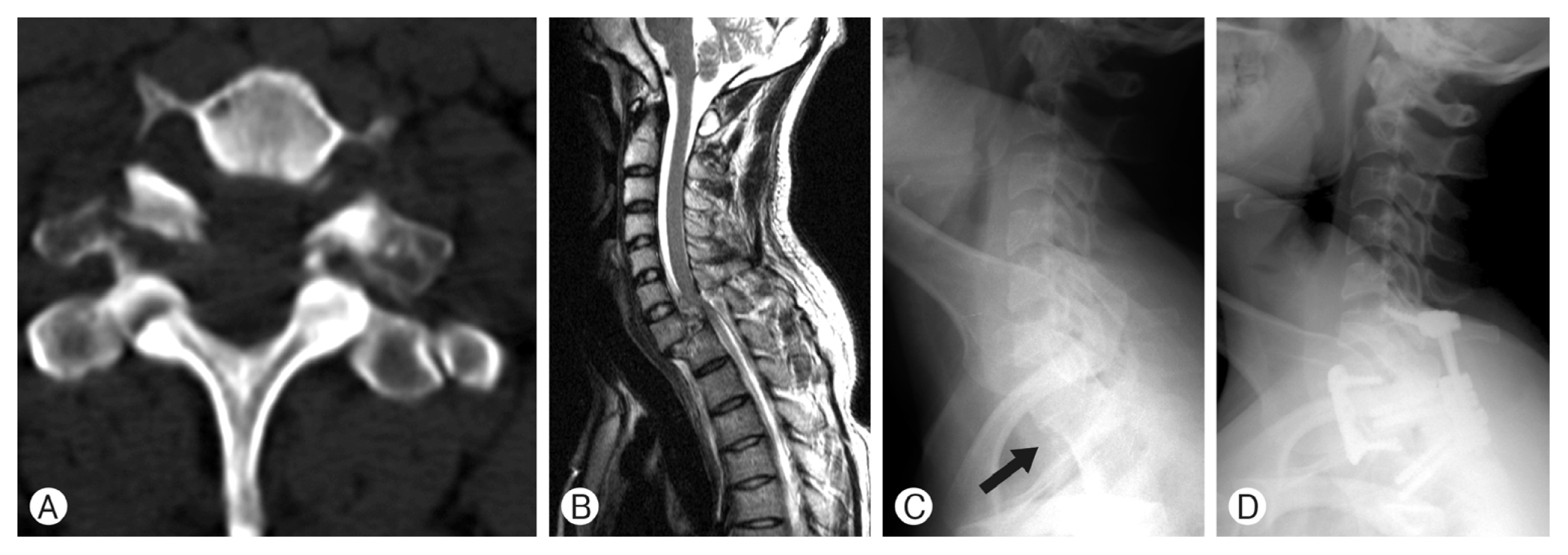INTRODUCTION
The cervicothoracic junction (CVJ) is a potentially unstable site due to an abrupt transition from the lordotic mobile cervical spine to the more rigid kyphotic thoracic spine. High-grade traumatic spondylolisthesis at the CVJ without neurological deficit is rare and should be treated with anterior and posterior stabilization techniques due to severely unstable fractures1-3). With its potential anatomic instability, lesions at the CVJ can lead to devastating spinal cord injury. The authors describe two cases of high-grade traumatic spondylolisthesis of C7 on T1 without neurological deficits and discuss clinical features and different surgical strategies according to patients’ condition.
CASE REPORT
1. Case 1
A 32-year-old man was referred to our institution with an episode of fall from a height of about 2.0 meter. The patient presented with severe posterior neck pain without any motor or sensory deficits. A lateral X-ray (Fig. 1A) of the cervical spine failed to show structural abnormality of the vertebrae. However, cervical computed tomography (CT) scan and magnetic resonance imaging (MRI) showed high-grade spondylolisthesis of C7 on T1 with bilateral jumped facets and bilateral C7 pars fractures with an increase in anteroposterior spinal canal dimension(Fig. 1B and C). In addition, the T2-weighted MRI revealed a ruptured, posteriorly herniated disc causing mild cord compression with no cord signal change (Fig. 1C). First, we performed a closed reduction using Gardner-Wells skeletal traction. Traction was started at 20 lbs and increased to 60 lbs, but the closed reduction has failed. Therefore, open reduction including resection of the fractured facet joint and instrumentation using the Atlas® cable system(Medtronic Sofamor Danek, Memphis, USA) were performed posteriorly. In a second operation, a discectomy C7-T1 was performed and a monosegmental fusion was added, using an autologous tricortical iliac autograft and Atlantis® anterior cervical plate system(Medtronic Sofamor Danek, Memphis, USA) (Fig. 1D). Post-operatively, the neurological status was not changed.
2. Case 2
A 42-year-old woman presented with severe posterior neck pain after falling 1.5 m down while she was hiking. Neurological examination showed no neurological deficits. CT (Fig. 2A) and MRI (Fig. 2B) revealed severe spondylolisthesis of C7 on T1 with bilateral C7 pars fracture and increased anteroposterior canal dimension. Sagittal T2 weighted MRI (Fig. 2B) demonstrated a disrupted and herniated disc causing cervical cord compression with no cord signal change. First, we performed a closed reduction using Gardner-Wells skeletal traction. Traction was started at 20 lbs and increased to 40 lbs, and the reduction was achieved successfully without neurologic deterioration, which was confirmed by the swimmer’s view (Fig. 2C). So anterior approach (anterior cervical discectomy and fusion) was first performed, followed by posterior approach (total laminectomy of C7, C6 lateral mass and T1-T2 transpedicular screw fixations) (Fig. 2D). Postoperatively, the patient remained neurologically intact.
DISCUSSION
Traumatic high-grade spondylolisthesis at the level C7/T1 should be considered as severely unstable fractures due to both anterior dislocation and multiple posterior element fractures1). Severe fracture-dislocation at the CVJ could be associated with complete and irreversible spinal cord injury, but several cases without neurological deficit have been reported even after post-traumatic C7-T1 spondyloptosis1-3). Fracture of the posterior elements can lead to a spontaneous decompression of the spinal canal and thereby preserve the spinal cord by the cord moving posteriorly2). So, severe neurological deficits could be avoided in case of fracture of the posterior elements.
When a patient with severe traumatic spondylolisthesis at the CVJ presents neurologically intact, the management becomes more complicated. Preservation of function and the safe restoration of anatomic alignment in the neurologically intact patients is crucial to minimize the extent of surgical stabilization and create a long-term stable construct of the fracture dislocation2). While closed reduction could be associated with significant neurological deterioration due to major disc herniation. However, most spine surgeons believe that close reduction is not associated with a higher incidence of disabling neurological deficit due to functional decompression of the spinal canal and advocate close reduction of a case of C7-T1 fracture dislocation with no neurological deficit1).
Although there have been different surgical managements for traumatic C7-T1 fracture dislocation, combined anterior-posterior instrumentation has been usually chosen as the most stable fixation techniques. An anterior approach has been favored as the initial surgical approach to avoid neurological deterioration in case of the presence of significant disc herniation and to prevent the risk of additional trauma in case of turning the patient on the operation table for the posterior approach1,2). Posterior open reduction of unreducible dislocations has been considered to be an initial effective surgical management by allowing direct disengagement of the inferior facet from the superior facet1).
In the present cases, combined anterior-posterior fixation underwent due to the destruction of both anterior and posterior elements. Based on success or failure of closed reduction and the presence of significant disc herniation, the initial surgical approach was chosen. In the first patient, closed reduction failed and the spinal canal was well maintained. Therefore, posterior open reduction and instrumentation was selected as an initial approach. In the second patient, MRI showed a disrupted and herniated disc, but the closed reduction was successful without neurological deterioration. So, the anterior approach was first performed, followed by posterior fusion.
CONCLUSION
Cervicothoracic juctional area should be examined carefully in acute traumatic injury to confirm hidden lesions. High-grade traumatic C7-T1 spondylolisthesis without neurological deficits is very rare. The management of a neurologically intact patient remains challenging due to its potential instability. However, a closed reduction can be recommended to restore anatomic alignment in neurologically intact patients because a posterior element fracture generally leads to a spontaneous posterior decompression of the spinal canal. Additionally, combined anterior-posterior approaches can provide good surgical outcomes, and the initial surgery is chosen based on success or failure of the closed reduction and the presence of the significant disc herniation.













